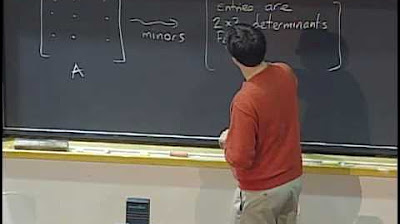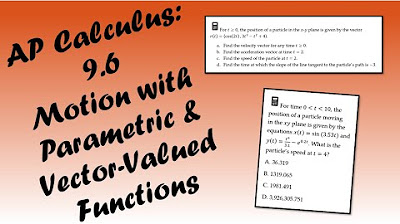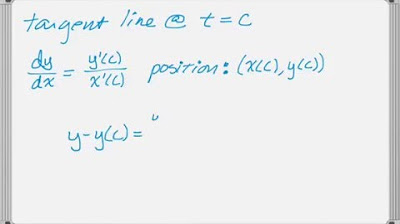Lec 7: Review | MIT 18.02 Multivariable Calculus, Fall 2007
TLDRThe lecture transcript covers a comprehensive review of vector operations, including dot and cross products, with applications in measuring angles, detecting perpendicularity, and calculating areas of spatial figures. It delves into matrices, linear systems, and the inversion of matrices, highlighting the importance of understanding these concepts for solving problems that may appear on an exam. The instructor also discusses parametric equations of motion, velocity, and acceleration, emphasizing the ability to derive and manipulate these equations. The summary of the practice exam problems provides insights into expected exam questions, focusing on practical applications of the discussed topics.
Takeaways
- 📚 The lecture covers a comprehensive list of topics, emphasizing that everything discussed so far is on the exam.
- 🔍 The importance of understanding the dot product of vectors, including its geometric interpretation and use in determining perpendicularity.
- 📐 The cross product is highlighted, with applications in finding areas of triangles and normal vectors to planes, and its role in determining the equation of a plane.
- 🧩 The significance of knowing how to compute determinants, especially for 2x2 and 3x3 matrices, which are essential for understanding the properties of vectors in space.
- 🔑 The role of parametric equations in describing motion, including how to derive them from given vectors and points, and their relation to velocity and acceleration.
- 🤔 The instructor clarifies that Taylor series, while useful, will not be on the exam, suggesting a focus on other topics.
- 📝 A reminder that students should be able to invert matrices by hand, as calculators won't be used in the exam, and the importance of this skill in solving linear systems.
- 🔄 The concept of rotation matrices is briefly mentioned, indicating that while specific formulas are not required, a general understanding is beneficial.
- 📈 The script touches on the use of vector identities and differentiation in proving properties of motion, such as Kepler's laws.
- 📉 The instructor provides guidance on what to expect on the exam, including the types of problems and the level of difficulty, reassuring students that the exam will be easier than some practice problems.
- ❓ The lecture includes an interactive Q&A session, addressing specific student concerns about the exam content, such as the necessity of knowing about parametrizing trigonometric functions and the use of Kepler's law.
Q & A
What is the main topic covered in the lecture?
-The main topic covered in the lecture is a comprehensive review for an exam, including vectors, dot and cross products, matrices, linear systems, rotation matrices, parametric equations, and vector calculus.
What is the significance of the dot product in the context of vectors?
-The dot product is used to measure angles between vectors, detect perpendicularity (when the dot product is zero), and can be geometrically interpreted as the product of the lengths of the vectors and the cosine of the angle between them.
How can the cross product be used to find the area of a triangle in space?
-The cross product of two vectors forming the sides of a triangle gives a vector perpendicular to the plane containing the triangle. The magnitude of this vector is equal to the area of the parallelogram formed by the two vectors, and half of this magnitude gives the area of the triangle.
What is the importance of knowing how to invert matrices by hand?
-Inverting matrices by hand is important even if calculators can do it, as it demonstrates a deeper understanding of the mathematical principles involved, which is a skill that may be required in exams and is useful in various mathematical and engineering applications.
What is the relevance of Taylor series in the context of this lecture?
-While Taylor series are not on the exam, they are mentioned as a concept that students should be aware of for general knowledge and potential use in solving real-life engineering problems.
Can you provide an example of how to find the parametric equations of a line?
-To find the parametric equations of a line, you need a point on the line and a vector parallel to the line. The parametric equations can be expressed as the initial point plus a parameter multiplied by the direction vector, giving x, y, and z in terms of the parameter.
What is the implication of a matrix having a determinant of zero?
-A matrix with a determinant of zero is not invertible, which means it may represent a system of equations with no solution or infinitely many solutions.
How can rotation matrices be used in the context of parametric equations?
-Rotation matrices can be used to rotate vectors in a plane by a certain angle, which is useful when dealing with parametric equations that involve motion in a plane, such as the rotation of a wheel.
What is the significance of finding the unit tangent vector in problems involving motion?
-The unit tangent vector is significant as it represents the direction of motion at a particular point on a path. It is the velocity vector divided by the speed, providing information about the orientation of the moving object.
How can the cross product be used to find the equation of a plane given three points?
-The cross product of two vectors formed from the given points gives a normal vector to the plane. Using this normal vector, the equation of the plane can be written in the form ax + by + cz = d, where a, b, and c are the components of the normal vector and d is found by substituting the coordinates of any of the points into the equation.
What is the relationship between the position vector R, its derivative, and acceleration when R has a constant length?
-If the position vector R has a constant length, then its derivative with respect to time (velocity vector v) is perpendicular to R. Furthermore, taking the derivative of the dot product R dot v (which is zero) with respect to time gives R dot a (acceleration) equals -v dot v, indicating that the acceleration is also perpendicular to the velocity if the speed is constant.
Outlines
📚 MIT OpenCourseWare Support and Exam Topics Overview
The script begins with an introduction to the MIT OpenCourseWare initiative, which offers free educational resources under a Creative Commons license. The speaker encourages donations to support the cause. The main body of the paragraph outlines the exam topics, emphasizing that the exam will cover everything taught so far, with a focus on vectors, dot products, and their geometric interpretations, including the detection of perpendicular vectors. Practice problems are suggested for better understanding, particularly problem 1 from Practice 1A, which is assumed to be well-understood by the students.
📘 Cross-Product Applications and Plane Equations
This paragraph delves into the concept of the cross-product, explaining its computation through determinants and its applications in finding the area of geometric shapes in space and determining normal vectors to planes. The process of deriving the equation of a plane using the normal vector components is discussed, along with the method of finding a normal vector by taking the cross-product of two vectors within the plane. An example from Practice 1A, problem 5, is mentioned to illustrate the concept.
🔍 Line Equations, Intersections, and Taylor Series Clarification
The speaker discusses the equations of lines, especially in parametric form, requiring a point on the line and a parallel vector. The process of deriving parametric equations from a given point and vector is explained. Additionally, the intersection of a line with a plane is covered. The paragraph also addresses a student's question about the Taylor series, clarifying that while it's useful for engineering problems, it will not be on the exam.
📐 Matrices, Inversion, and Linear Systems
The paragraph focuses on matrices, linear systems, and the inversion of matrices. It is emphasized that students should be able to invert matrices by hand, despite the availability of calculators. The importance of recognizing whether a matrix is invertible by checking the determinant is highlighted. The potential exam question related to matrix inversion is anticipated, and the connection between the practice tests and the likelihood of similar questions on the actual exam is pointed out.
🚀 Vector Analysis and Motion Parametrization
The speaker discusses the analysis of motion using vectors, including the decomposition of position vectors and the derivation of parametric equations for motion. The process involves differentiating vector identities to prove certain motions, such as Kepler's laws, which are not required to be known in detail for the exam. The emphasis is on the ability to manipulate vector quantities and understand the basics of velocity and acceleration as derivatives of position vectors.
📝 Practice Exam 1A Review and Matrix Inversion
The paragraph reviews Practice Exam 1A, specifically problem 3, which involves finding unknown values in the inverse of a given matrix. The steps for inverting a matrix, including computing minors, cofactors, transposing, and dividing by the determinant, are outlined. The process is demonstrated with a focus on efficiency, highlighting the computation of only necessary minors and cofactors to solve for the unknowns.
🔄 Matrix Modification and Solution Space Exploration
This section explores the implications of modifying a matrix by changing a single element, leading to a non-invertible matrix when the determinant is zero. The value of the element that causes non-invertibility is calculated. Subsequently, the system of equations corresponding to this matrix is examined, revealing either no solution or infinitely many solutions, with the latter being the case. The cross-product method is introduced to find a vector solution to the system.
📍 Geometric Interpretation of Solutions and Planes
The speaker provides a geometric interpretation of the solutions to the system of equations, explaining that the solutions form a line within the space defined by three planes. The cross-product is used to find a direction vector perpendicular to the planes, which represents the line of solutions. The process of finding all solutions by understanding the geometric relationship between the planes and their normal vectors is discussed.
📌 Vector Operations and Plane Equations in Practice
The paragraph covers practical applications of vector operations, specifically the calculation of the area of a spatial triangle using the cross-product, and the derivation of a plane equation given three points. The process involves forming vectors from the points, calculating their cross-product, and using it to establish the plane equation. The intersection of a line with the plane is also discussed, illustrating the use of parametric equations and vector methods to solve problems.
🛫 Derivatives of Vector Dot Products and Constant Length Vectors
The final paragraph addresses the derivative of a dot product between a position vector and itself, explaining the application of the product rule in the context of vector calculus. It also presents a proof that if a vector maintains a constant length, it is perpendicular to its velocity vector. The relationship between the position vector, velocity, and acceleration is explored, leading to the calculation of the dot product of the position vector and the acceleration vector.
Mindmap
Keywords
💡Dot-product
💡Cross-product
💡Determinant
💡Parametric equations
💡Vector
💡Perpendicular vectors
💡Matrix inversion
💡Linear systems
💡Normal vector
💡Taylor series
💡Rotation matrices
💡Velocity and acceleration
Highlights
The exam covers a comprehensive range of topics, including vectors, dot and cross products, and their applications.
Dot-product is used for measuring angles between vectors and detecting perpendicularity.
Cross-product is essential for computing the area of a triangle in space and finding a vector perpendicular to two given vectors.
Understanding determinants, especially for 2x2 and 3x3 matrices, is crucial for vector operations.
Parametric equations of a line require a point on the line and a vector parallel to it.
Taylor series, while useful, are not required for the exam.
Matrices, linear systems, and inverting matrices by hand are key topics for the exam.
The determinant of a matrix indicates whether a system has a unique solution, no solution, or infinitely many solutions.
Rotation matrices and their applications in 2D and 3D spaces are discussed, though not required for memorization.
Parametric equations can be found by decomposing the position vector into simpler vectors.
Velocity and acceleration are derived from the first and second derivatives of a position vector.
Differentiating vector identities is a method to prove things about motions, such as Kepler's laws.
The exam will likely include problems on parametric motions and their applications.
Parametrizing trigonometric functions is not a focus, but basic trigonometry is required for certain problems.
Proofs on the exam will be straightforward and not overly complex.
Equations of 3D shapes like planes, lines, circles, and spheres are essential, but more complex shapes are not required at this stage.
Formulas proved in homework can be assumed on the test, but should be referenced to avoid ambiguity.
Conversion between parametric and Cartesian equations is expected only for simple cases.
Knowledge of the unit tangent vector is necessary, as it is velocity divided by speed.
Kepler's law can be used if it aids in problem-solving, but detailed knowledge is not required.
Calculating the distance between two lines or planes is not expected to be on the exam.
The process of inverting a matrix is demonstrated through a practice problem, emphasizing the steps of computing minors, cofactors, transposing, and dividing by the determinant.
A matrix is not invertible when its determinant is zero, leading to either no solution or infinitely many solutions.
Finding the cross-product of two vectors in a system with a zero determinant reveals the line of solutions.
Parametric equations for motion involve expressing the position vector as a function of a parameter, often time.
Problem 5 of practice exam 1A illustrates the use of cross-product for area calculation, plane equation derivation, and intersection points of a plane and a line.
Problem 6 involves vector calculus, specifically the relationship between a position vector of constant length and its velocity and acceleration vectors.
Transcripts
Browse More Related Video

Lec 34: Final review | MIT 18.02 Multivariable Calculus, Fall 2007

Polar, Parametric, Vector Multiple Choice Practice for Calc BC (Part 2)

AP Calculus BC Lesson 9.6

AP Calculus BC Parametric and Vector AP Exam Review

Polar, Parametric, Vector Multiple Choice Practice for Calc BC (Part 4)

2022 Live Review 1 | AP Physics 1 | Understanding Motion and Kinematics
5.0 / 5 (0 votes)
Thanks for rating: